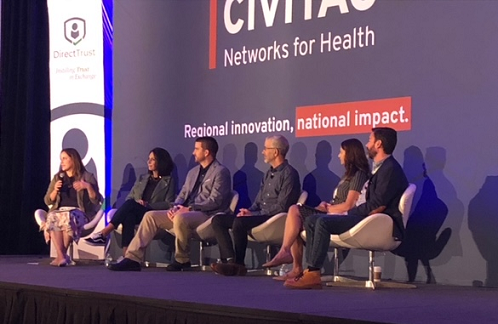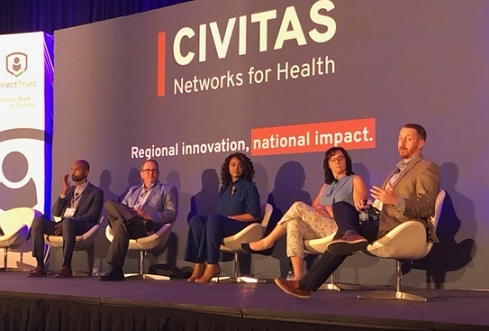Day 2 of sessions at the Civitas and DirectTrust Better Together 2022 Conference with Beth Friedman. Here are her notes and takeaways from Tuesday, August 23rd.
TEFCA: Dispelling Myths, Highlighting Motivations, and Understanding Participation
Speakers
- Alan Swenson, Carequality
- Julie Maas, MEng, MBA, EMR Direct
- Jay Nakashima, MBA, eHealth Exchange
- John Kansky, MBA, MSE, CPHIMS, IHIE
- Lisa Bari, MBA, MPH, Civitas Networks for Health
- Jon Elwell, Kno2
- Zoe Barber, MPH. The Sequoia Project
- Steven Lane MD MPH, Health Gorilla

Noted & Quoted
Jay Nakashima: “Very hopeful that with TEFCA gaining credibility, we can start chipping away at non-treatment related data exchange needs.”
Dr. Steven Lane: “Very excited. Been working over a decade to accelerate interoperability in my practice. Providers are drowning in data now—too much push and pull, data all over the place. It’s not perfect, but the promise of TEFCA, architecture and design, etc. provides federally-supported framework that we can all use to move forward that today is disparate, different, exchange pathways.”
“New communities and stakeholders need to be engaged. Patients have support teams that go well beyond the physician. Many of these communities are completed unconnected to our current interoperability framework and don’t have EHRs. TEFCA is an opportunity also for them.”
Alan Swenson: Future of Carequality includes continual movement forward. We’ll see organizations continue to exchange with other organizations through Carequality, and use TEFCA for organizations they aren’t connected for other purposes. Will start to see other types of connections materialize through TEFCA. A lot is still unknown as for what will happen with TEFCA over the next few years.”
Individual access and TEFCA
Jay Nakashima: Concerns about patient matching algorithms used that takes us back to hte need for a unique patient identifie
Jon Elwell: The need and opportunity is significant, the way to get there still has some bumps
Julie Maas: Individual access services has come up for a long time. Not completely solved, but we’ve heard from a lot of people re: privacy concerns, digital identify, proxy for national identifier, and more. Patient matching is a big part of identify services. It will be a long process to get to a high level of confidence to achieve individual access.
Alan Swenson: Demographics-based patient matching is a concern on a lot of levels. Improvements are being worked on, but we’ll be working on this for quite a while to really solve the problem.
After the #QHIN application is published, there will be a 30 day buffer. There will be no “first QHIN”, it will be a cohort of #QHINs. – @ZoeBarber from @sequoiaproject at #Together4Health2022 @civitas4health pic.twitter.com/XrPILiRZqE
— DirectTrust (@DirectTrustorg) August 23, 2022
Federal Programs Catalyzing Health Equity Initiatives
Panel
- Larry Jessup, MHA, ONC
- William Marella, MBA, MMI, HealthShare Exchange
- Denise Hines, DHA, PMP, FHIMSS, Georgia Health Information Network+
- George Gooch, THSA
- Sonia Chambers, WV Health Information Network

Takeaways
STAR HIE Program – Designed to strengthen uses of health information via HIEs to support public health agencies, including for COVID response. $5M from CURES Act. But not only about COVID 19.
Greater Philadelphia/Delaware Valley: HSX – included health equity strategies in COVID response (case findings, contact tracing, vaccine rollout to mobility-impaired homebound). Beyond COVID-19 new opportunities with public health, connected residents with 19 different benefit programs (partnership with PA Dept of Aging), statewide SDOH platform, incorporating health equity into pop health collaboratives
Georgia: GaHIN. query-based exchange for all members plus secure messaging and they use DirectTrust. Receive ADT alerts for hospitals connected (15K connected providers). 5 connected state agencies. Medicaid patient care plans shared. When ONC STAR grant came up, GA jumped in – relationship with Medicaid agency also jumped. Connected correctional facilities. Created an inter-agency agreement with Medicaid that became the infrastructure for public health. Beyond COVID-19: ONC STAR HIE Health Equity Workgroup. Short-term initiative that was extended. Several topics, but also bring in clinicians (ask them what they need).
West Virginia: WVHIN. Uses CRISP shared infrastructure-services. When COVID hit, only 4 hospitals were reporting labs. Within 2 weeks, stood up 20+ more feeds. As rapid tests emerged across multiple locations, the state mandated electronic reporting of these results. CRISP had already developed a way to enter data, so they capitalized on this and turned into an online form to be completed and submitted very quickly. But testing facilities weren’t very focused on capturing race, ethnicity, etc. So they integrated test results with CRISP data to integrate, send to state. Also a gap in physician communications—telling PCPs that the patient has COVID. Then moved to bidirectional immunization reporting (Immuntrack patient navigator and heat maps at pop health mngt level) with race, ethnicity, chronic conditions from CMS data, etc. So providers can now see for their patients. Target marketing using the heat maps to get more people to get their vaccines by county, race, ethnicity, social vulnerability.
“Health equity in West Virginia has more to do with “place” than race.” STAR program opened the door to address more vaccine equity, health disparities, data cleanup (patient matching in hospitals systems vs. HIE platforms), share data across borders with Ohio. All this translates into other mechanisms to look at all immunizations – sets us up for the future to do regular work and next issues that may come along.
Texas: THSA. George Gooch. Operates 2 functions: HIETexas and SECURETexas ( a privacy and security certification program). One of 5 STAR HIE Program award winners. Additionally awarded supplemental award under STAR. Participates in STAR HIE Health Equity Planning Council.
Texas is mostly rural. Many. don’t have full time IT teams. Interoperability works in different ways across the state. Encounter alerting functionality service (Audacious Inquiry) used. Smart alerts include SDOH based on ICD-10 codes and other indicators (e.g. experiencing homelessness).
“STAR Program helped push HIEs and public health together. Our work collaboration was highlighted and advanced during the pandemic.”
 Beth Friedman, Senior Partner at FINN Partners
Beth Friedman, Senior Partner at FINN Partners
Beth’s professional experience includes work with hospitals, health systems, medical groups, health IT vendors, associations, and marketing agencies. She has experienced the healthcare industry from every aspect. And walked in many shoes.
Follow her on Twitter @HealthITPR
Connect with her on LinkedIn at Beth Friedman
